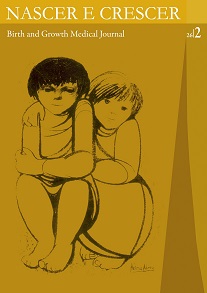CHROMOSOMAL INSTABILITY AND IMMUNODEFICIENCY – ESSENTIAL FOR THE DIAGNOSIS OF NIJMEGEN SYNDROME
DOI:
https://doi.org/10.25753/BirthGrowthMJ.v26.i2.9562Keywords:
Nijmegen Breakage Syndrome, chromosomal instability, immunodeficiencyAbstract
Introduction: Nijmegen breakage syndrome (NBS) is a rare autosomal recessive disorder that belongs to the group of chromosomal instability syndromes, more prevalent in Central and Eastern Europe.
Clinical case: We describe the case of a 14-month-old boy, born to Ukrainian parents, that presented at birth with microcephaly, small to gestational age and dysmorphic facial characteristics, which became more obvious with age. The complementary study revealed spontaneous and induced chromosomal instability, with normal fetal haemoglobin and α-fetoprotein and cellular immunodeficiency. These features suggested NBS, confirmed by the identification of the founder mutation (657del5) in homozygous state, common in patients of Slavic origin.
Discussion: NBS should be considered in the presence of microcephaly, typical facial features, growth retardation, chromosomal instability and immunodeficiency. The prognostic is poor due to the occurrence of frequent infections and the high incidence of cancer. Multidisciplinary follow-up and avoidance of radiation exposition are crucial.
Downloads
References
Taylor AMR. Chromosome instability syndromes. Best
Practice Research Clinical Haematology. 2001; 14:631-44
Weemaes CM, Hustinx TW, Scheres JM, van Munster PJ,
Bakkeren JA, Taalman RD. A new chromosomal instability
disorder: the Nijmegen breakage syndrome. Acta Paediatr
Scand. 1981; 70:557–64.
Chrzanowska KH, gregorek H, Dembowska-Baginska B,
Kalina MA, Digweed M. Nijmegen Breakage Syndrome.
Orphanet Journal of Rare Diseases. 2012; 7:13.
The International Nijmegen Breakage Syndrome Study
Group. Nijmegen Breakage Syndrome. Arch Dis Child. 2000;
:400-6.
Chrzanowska K, Kalina M, Rysiewski H, Gajdulewicz M,
Szarras-Czapnik M, Gajtko-Metera M, et al. Growth pattern
in patients with Nijmegen breakage syndrome: evidence
from a longitudinal study [abstract]. Horm Res Paediatr.
; 74(Suppl 3):s38.
Chrzanowska KH, Szarras-Czapnik M, Gajdulewicz M,
Kalina MA, Gajtko-Metera M, Walewska-Wolf M, et al. High
prevalence of primary ovarian insufficiency in girls and
young women with Nijmegen breakage syndrome: evidence
from a longitudinal study. J Clin Endocrinol Metab. 2010;
:3133-40.
Bekiesińska-Figatowska M, Chrzanowska KH, Sikorska J,
Walecki J, Krajewska-Walasek M, Jóźwiak S. Cranial MRI
in the Nijmegen breakage syndrome. Neuroradiology. 2000;
:43–7.
Bekiesińska-Figatowska M, Chrzanowska KH, Jurkiewicz
E, Wakulińska A, Rysiewski H, Gładkowska-Dura M, et al.
Magnetic resonance imaging of brain anormalities in patients
with the Nijmegen breakage syndrome. Acta Neurobiol Exp.
; 64:503-9.
Gregorek H, Chrzanowska KH, Michalkiewicz J, Syczewska
M, Madalinski K. Heterogeneity of humoral immune
abnormalities in children with Nijmegen breakage syndrome:
an 8-year follow-up study in a single centre. Clin Exp
Immunol. 2002; 130:319–24.
Gregorek H, Chrzanowska KH, Dzierżanowska-Fangrat
K, Wakulińska A, Pietrucha B, Zapaśnik A, et al. Nijmegen
breakage syndrome: long-term monitoring of viral and
immunological biomarkers in peripheral blood before
development of malignancy. Clin Immunol. 2010;135: 440–7.
Pérez-Vera P, González-del Angel A, Molina B, Gómez
L, Frías S, Gatti RA, et al. Chromosome instability with
bleomycin and X-ray hypersensitivity in a boy with Nijmegen
breakage syndrome. Am J Med Genet. 1997; 70:24–7.
Chrzanowska KH, Stumm M, Bekiesińska-Figatowska M,
Varon R, Białecka M, Gregorek H, et al. Atypical clinical
picture of the Nijmegen breakage syndrome associated with
developmental abnormalities of the brain. J Med Genet.
; 38:E3.
Gennery AR, Slatter MA, Bhattacharya A, Barge D, Haigh S,
O’Driscoll M, et al. The clinical and biological overlap between
Nijmegen Breakage Syndrome and Fanconi anemia. Clin
Immunol. 2004; 113:214–9.
Ben-Omran TI, Cerosaletti K, Concannon P, Weitzman
S, Nezarati MM. A patient with mutations in DNA Ligase
IV: clinical features and overlap with Nijmegen breakage
syndrome. Am J Med Genet A. 2005; 137A:283–7.
Varon R, Seemanova E, Chrzanowska K, Hnateyko O,
Piekutowska-Abramczuk D, Krajewska-Walasek M, et al.
Clinical ascertainment of Nijmegen breakage syndrome
(NBS) and prevalence of the major mutation, 657del5, in
three Slav populations. Eur J Hum Genet. 2000; 8:900–2.
Downloads
Additional Files
Published
How to Cite
Issue
Section
License
Copyright and access
This journal offers immediate free access to its content, following the principle that providing free scientific knowledge to the public provides greater global democratization of knowledge.
The works are licensed under a Creative Commons Attribution Non-commercial 4.0 International license.
Nascer e Crescer – Birth and Growth Medical Journal do not charge any submission or processing fee to the articles submitted.


